Sharp restyle for Corsa likely
/Opel appears to be undertaking a design update for the newly-arrived Corsa.
Read MoreOpel appears to be undertaking a design update for the newly-arrived Corsa.
Read MoreSmall hatch becomes second Opel to position below a French donor.
Read More
THE first to wear Peugeot’s new logo – and pretty much everything behind that fresh ‘coat of arms’ moniker is fresh, as well.
So it goes for the next-generation 308 hatchback, revealed internationally today and set to land in early 2022, a timing that might well synch neatly with the distributor opening a smart new flagship dealership.
The latest car won‘t seem like a wholly new start, in that it carries over much of the silhouette of the outgoing model - the same chunky, snub-nose and retaining a deep c-pillar; however the detailing is very different.
Still, the aerodynamic efficiency has improved, cutting drag to 0.28Cd, body stiffness has been boosted by using aircraft-style adhesive in key areas and the chassis, though a variation of the current car’s EMP2 platform, has been significantly upgraded. The wheelbase is 55mm longer, which should free up more rear seat space, and total length has gone up by 110mm. The car also sits 20mm lower to the road.
The 308 launches with three versions of the familiar 1.2-litre PureTech three-cylinder turbo petrol engine, in 82kW and 97kW forms, with an eight-speed automatic gearbox, but will also deliver in electrified versions too - a pair of plug-in hybrids, using the 1.6-litre turbo PureTech four-cylinder petrol engine, combined with an 81kW electric motor and a 12.4kWh battery.
The powerhouse version of that line makes 168kW, with CO2 emissions of 26 grams per kilometre, and an electric range of 59km. Peugeot also does a 132kW version, with CO2 emissions of 25g/km and an electric range of 60km.
There’s talk a high-performance 308 Peugeot Sport Engineered will come along in due course, powered by a 220kW, all-wheel-drive version of the PHEV system.
PHEV versions have an optional 7.4kW charging system which will allow them to be fully charged in one hour and 50 minutes (or just under four hours with the standard 3.7kW charging system).
In Europe Peugeot will offer PHEV buyers membership of the Peugeot Easy-Charge system which will include access to 220,000 public charging points. The PHEV 308s' batteries will be warrantied for eight years or 160,000km.
A new Drive Assist 2.0 pack includes adaptive cruise control with Stop and Go function – just with the auto, but it’s very likely that will be the sole transmission choice here - and a lane keeping aid. There's also a new function, which suggests the best moments to change lanes to overtake slower moving traffic. A system that adjusts the cruise control speed if a corner is coming up also debuts.
High-set instruments and a small, low-set wheel … yup, that i-Cockpit seems set to stay. Upmarket editions have a fully-digital '3D' ten-inch screen for the instrument panel, while the central touchscreen is also 10 inches across. This now comes with two separate control areas, aside from the main screen, one showing a panel of "fully configurable virtual i-toggles" - a series of touchscreen buttons of which you can decide the layout and functions.
Wireless phone connectivity for Apple CarPlay and screen mirroring is standard. A 10-speaker Focal sound system, eight-colour ambient LED lighting, and a selection of USB ports also feature. There's over-the-air software updates and also a 'Hello, Peugeot' digital voice assistant.
Front seat occupants achieve 10-way power-adjustable massaging chairs, trimmed in Alcantara and leather with contrast stitching. There's also a new air filtration system, which prevents airborne pollutants from entering the cabin.
The auto’s gear selector is a toggle-type and there’s a button for selecting Electric, Hybrid, Eco, Normal and Sport modes, depending upon which engine you've chosen.
Four hundred and 12 litres of boot space is availed with the rear seats up, an eight litre reduction on the current car, expanding to 1323 litres with the second row folded. An additional 34 litres of storage space can be utilised through small compartments spread around the cabin
Styling-wise, the 308 gets the deep, concave grille, slim headlights, and 'fang' LED daytime running lights from the recently-facelifted 3008 and 5008 crossovers. At the back, it has slim-fit brake lights with a connecting light bar running across the boot lid. The new badge, set into the centre of the grille, is designed so that the radar unit for the active cruise control can now sit behind it.
The new model’s entry could coincide with the opening of a three-storey Peugeot Citroen supersite the Armstrong motor group will build in Greenlane, Auckland. It will also be one of the first premises in the world to feature the new Peugeot brand identity.
Armstrong’s managing director Rick Armstrong, whose Autodistributors’ NZ holds national distribution rights to PSA brands, says the building is a sign of the group’s commitment to the Peugeot and Citroen marques and is an indicator of what it believes is the huge future growth opportunity for the two brands.

TOTALLY electric and a petrol powertrain for those who aren’t ready to plunge into a fully battery-propelled motoring future.
That’s the proposed strategy Citroen’s New Zealand importer, Auto Distributors, hopes to realise with the new-generation C4, revealed internationally this week.
The national potential for a model that has now fully released from a hatchback styling to embrace a crossover look previously limited to the offshoot C4 Cactus is for it to primarily deliver as Citroen’s breakthrough into the electric vehicle sphere, following a similar model from sister brand Peugeot, also with the same national distributor.
“One of the strengths of new C4 is choice of powertrain and we would like to provide options to Citroen customers, rather than limit them,” explains Auto Distributors’ commercial manager, Arek Zywot in explaining interest in the new e-C4.
“We do not know specific launch date as yet, although we are aiming to have it here by the end of quarter two (of) 2021.
“We are looking at two possible drivetrains: EV and petrol automatic.”
He’s comfortable with the styling direction cementing with a crossover aspect that, though more rakish and less ‘other worldly’ than the C4 Cactus look thanks to Citroen adopting a fastback roofline, nonetheless stays true to existing fundamentals.
“C4 is a continuation of a model that is replacing C4 Cactus and many of the design elements have transferred to the new model.”

C4 is, of course, based on the same underpinnings as the latest Peugeot 208 and 2008, also earmarked for NZ introduction and the drivetrains are identical. Just one petrol engine is expected, a 1.2-litre in three stages of tune: 74kW, 95kW and 114kW, operating through an eight-speed automatic gearbox and driving the front wheels. The e-C4 is expected to make use of a 50kWh lithium battery that will power an electric motor, developing around 100kW, on the front axle. The same powertrain in the e-2008 delivers a range of 320km, albeit when measured on the fabulously optimistic Worldwide Harmonised Light Vehicles Test Procedure.
All models will have the firm’s new progressive hydraulic suspension set-up, according to overseas’ reports. The car’s springs and shock absorbers work with hydraulic compression and rebound stops, which are designed to gradually slow body movement over bumps and potholes.
The progression to a crossover look is in response to hatch desirability having been undermined by the sports utility boom, Citroen acknowledges.
Citroen’s CEO Vincent Cobee says it’s all about finding the “proper balance between affordability, versatility and comfort, better access, and better visibility, as there’s probably also a need for more spice in the style.”
The electric and orthodox cars are identical in overall look and styling cues from the larger C5 Aircross are evident, but it also plucks from past Citroens. The shape of the third side window links to some of Citroen's earlier family cars, such as the GS, introduced in 1970.

The one detail to differentiate an e-C4 from the oil-reliant type is that the former has blue-lit badge surrounds.
The cabin is seen as a gentle redesign of what we can see in the current C4 Cactus, but with a new digital dashboard and instrument binnacle and a redesigned centre console.
Citroen says its has put a major focus on comfort when designing every part of the cabin, including the seats and the dashboard.
The electric-read CMP platform has become a vital attraction to Fiat Chrysler Automobiles, which is in the process of merging with Peugeot-Citroen parent PSA. It's one of two architectures that will underpin over two thirds of the merged group's combined annual production. It’s thought the Alfa Romeo Tonale crossover will be built on this underpinning.

MotoringNZ reviews new cars and keeps readers up-to-date with the latest developments on the auto industry. All the major brands are represented. The site is owned and edited by New Zealand motoring journalist Richard Bosselman.